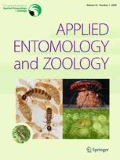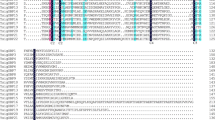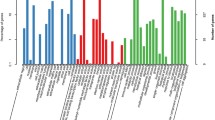Abstract
Odorant-binding proteins (OBPs) and chemosensory proteins (CSPs) play important roles in insect chemosensory systems. In the Asian corn borer Ostrinia furnacalis (Guenée) (Lepidoptera: Crambidae), only a fraction of them have been examined for their expression patterns. In this study, we compared the expression levels of 24 OBPs and 19 CSPs between sexes using quantitative RT-PCR. Sexually biased expression was observed for 17 OBPs and 7 CSPs in virgin individuals. Expression levels of 18 OBPs and 10 CSPs changed after mating, resulting in sexually biased expression in 16 OBPs and 1 CSP. The effect of mating was sex-specific in 9 OBPs and 2 CSPs. These results suggest a sexually divergent molecular composition and may indicate a functional divide between OBP and CSP genes in the chemosensory system of O. furnacalis.





Similar content being viewed by others
References
Allen JE, Wanner KW (2011) Asian corn borer pheromone binding protein 3, a candidate for evolving specificity to the 12-tetradecenyl acetate sex pheromone. Insect Biochem Mol Biol 41:141–149
Anderson P, Anton S (2014) Experience-based modulation of behavioural responses to plant volatiles and other sensory cues in insect herbivores. Plant Cell Environ 37:1826–1835
Barrozo RB, Jarriault D, Simeone X, Gaertner C, Gadenne C, Anton S (2010) Mating-induced transient inhibition of responses to sex pheromone in a male moth is not mediated by octopamine or serotonin. J Exp Biol 213:1100–1106
Blomquist GJ, Vogt RG (2003) Biochemistry of female moth sex pheromones. Insect pheromone biochemistry and molecular biology. Elsevier, London
Cao DP, Liu Y, Wei JJ, Liao XY, Walker WB, Li J et al (2014) Identification of candidate olfactory genes in Chilo suppressalis by antennal transcriptome analysis. Int J Biol Sci 10:846–860
Dorhout DL, Sappington TW, Rice ME (2008) Evidence for obligate migratory flight behavior in young European corn borer (Lepidoptera: Crambidae) females. Environ Entomol 37:1280–1290
Fitzpatrick SM, McNeil JN (2012) Male scent in lepidopteran communication: the role of male pheromone in mating behaviour of Pseudaletia unipuncta (Haw.) (Lepidoptera: Noctuidae). Mem Entomol Soc Can 120:131–151
Garczynski SF, Coates BS, Unruh TR, Schaeffer S, Jiwan D, Koepke T et al (2013) Application of Cydia pomonella expressed sequence tags: identification and expression of three general odorant binding proteins in codling moth. Insect Sci 20:559–574
Glaser N, Gallot N, Legeai F, Montagne N, Poivet E, Harry M et al (2013) Candidate chemosensory genes in the stemborer Sesamia nonagrioides. Int J Biol Sci 9:481–495
Glover TJ, Perez N, Roelofs WL (1989) Comparative analysis of sex-pheromone response antagonists in three races of European corn borer. J Chem Ecol 15:863–873
Gong DP, Zhang HJ, Zhao P, Lin Y, Xia QY, Xiang ZH (2007) Identification and expression pattern of the chemosensory protein gene family in the silkworm, Bombyx mori. Insect Biochem Mol Biol 37:266–277
Gong DP, Zhang HJ, Zhao P, Xia QY, Xiang ZH (2009) The odorant binding protein gene family from the genome of silkworm Bombyx mori. BMC Genom 10:3322
Grabherr MG, Haas BJ, Yassour M, Levin JZ, Thompson DA, Amit I et al (2011) Full-length transcriptome assembly from RNA-seq data without a reference genome. Nat Biotechnol 29:644–652
Grosse-Wilde E, Kuebler LS, Bucks S, Vogel H, Wicher D, Hansson BS (2011) Antennal transcriptome of Manduca sexta. Proc Natl Acad Sci USA 108:7449–7454
Gu SH, Sun L, Yang RN, Wu KM, Guo YY, Li XC et al (2014) Molecular characterization and differential expression of olfactory genes in the antennae of the black cutworm moth Agrotis ipsilon. PLoS One 9:e103420
Haas BJ, Papanicolaou A, Yassour M, Grabherr M, Blood PD, Bowden J et al (2013) De novo transcript sequence reconstruction from RNA-seq using the Trinity platform for reference generation and analysis. Nat Protocols 8:1494–1512
Hekmat-Scafe DS, Scafe CR, McKinney AJ, Tanouye MA (2002) Genomewide analysis of the odorant-binding protein gene family in Drosophila melanogaster. Genome Res 12:1357–1369
Hoeppner MP, Lundquist A, Pirun M, Meadows JRA, Zamani N, Johnson J et al (2014) An improved canine genome and a comprehensive catalogue of coding genes and non-coding transcripts. PLoS One 9:e91172
Huang YP, Honda H, Yoshiyasu Y, Hoshizaki S, Tatsuki S, Ishikawa Y (1998a) Sex pheromone of the butterbur borer, Ostrinia zaguliaevi. Entomol Exp Appl 89:281–287
Huang YP, Takanashi T, Hoshizaki S, Tatsuki S, Honda H, Yoshiyasu Y et al (1998b) Geographic variation in sex pheromone of Asian corn borer, Ostrinia furnacalis, in Japan. J Chem Ecol 24:2079–2088
Ishikawa Y, Takanashi T, Huang YP (1999) Comparative studies on the sex pheromones of Ostrinia spp. in Japan: the burdock borer Ostrinia zealis. Chemoecology 9:25–32
Jacquin-Joly E, Legeai F, Montagne N, Monsempes C, François MC, Poulain J et al (2012) Candidate chemosensory genes in female antennae of the noctuid moth Spodoptera littoralis. Int J Biol Sci 8:1036–1050
Jurenka RA, Blomquist G, Vogt R (2003) Biochemistry of female moth sex pheromones. Insect pheromone biochemistry and molecular biology. Elsevier, London
Katoh K, Toh H (2010) Parallelization of the MAFFT multiple sequence alignment program. Bioinformatics 26:1899–1900
Kaupp UB (2010) Olfactory signalling in vertebrates and insects: differences and commonalities. Nat Rev Neurosci 11:188–200
Leal WS (2005) Pheromone reception. Top Curr Chem 240:1–36
Leal WS (2013) Odorant reception in insects: roles of receptors, binding proteins, and degrading enzymes. Annu Rev Entomol 58:373–391
Lemey P, Rambaut A, Drummond AJ, Suchard MA (2009) Bayesian phylogeography finds its roots. PLoS Comput Biol 5:e1000520
Liu Y, Gu SH, Zhang YJ, Guo YY, Wang GR (2012) Candidate olfaction genes identified within the Helicoverpa armigera antennal transcriptome. PLoS One 7:e48260
Liu NY, Xu W, Papanicolaou A, Dong SL, Anderson A (2014) Identification and characterization of three chemosensory receptor families in the cotton bollworm Helicoverpa armigera. BMC Genom 15:597
Miura N, Nakagawa T, Touhara K, Ishikawa Y (2010) Broadly and narrowly tuned odorant receptors are involved in female sex pheromone reception in Ostrinia moths. Insect Biochem Mol Biol 40:64–73
Mortazavi A, Williams BA, McCue K, Schaeffer L, Wold B (2008) Mapping and quantifying mammalian transcriptomes by RNA-Seq. Nat Methods 5:621–628
Mutuura A, Munroe E (1970) Taxonomy and distribution of European corn borer and allied species genus Ostrinia (Lepidoptera: Pyralidae). Mem Entomol Soc Can 102:1–112
Ohno S (2003) A new knotweed-boring species of the genus Ostrinia Hübner (Lepidoptera: Crambidae) from Japan. Entomol Sci 6:77–83
Pelosi P, Maida R (1995) Odorant-binding proteins in insects. Comp Biochem Physiol B 111:503–514
Pelosi P, Zhou JJ, Ban LP, Calvello M (2006) Soluble proteins in insect chemical communication. Cell Mol Life Sci 63:1658–1676
Petersen TN, Brunak S, von Heijne G, Nielsen H (2011) SignalP 40: discriminating signal peptides from transmembrane regions. Nat Methods 8:785–786
Pickett JA, Ardottir GI, Birkett MA, Bruce TJA, Chamberlain K, Khan ZR et al (2012) Aspects of insect chemical ecology: exploitation of reception and detection as tools for deception of pests and beneficial insects. Physiol Entomol 37:2–9
Reisenman CE, Riffell JA, Bernays EA, Hildebrand JG (2010) Antagonistic effects of floral scent in an insect–plant interaction. Proc Roy Soc Lond B 277:2371–2379
Roberts A, Pachter L (2012) Streaming fragment assignment for real-time analysis of sequencing experiments. Nat Methods 10:71–73
Roelofs WL, Du JW, Tang XH, Robbins PS, Eckenrode CJ (1985) Three European corn borer populations in New York based on sex pheromones and voltinism. J Chem Ecol 11:829–836
Sanchez-Gracia A, Vieira FG, Rozas J (2009) Molecular evolution of the major chemosensory gene families in insects. Heredity 103:208–216
Shirai Y (1998) Laboratory evaluation of flight ability of the Oriental corn borer, Ostrinia furnacalis (Lepidoptera: Pyralidae). Bull Entomol Res 88:327–333
Spaethe A, Reinecke A, Olsson SB, Kesavan S, Knaden M, Hansson BS (2013) Plant species- and status-specific odorant blends guide oviposition choice in the moth Manduca sexta. Chem Senses 38:147–159
Stamatakis A, Aberer AJ, Goll C, Smith SA, Berger SA, Izquierdo-Carrasco F (2012) RAxML-light: a tool for computing terabyte phylogenies. Bioinformatics 28:2064–2066
Takanashi T, Ohno S, Huang YP, Tatsuki S, Honda H, Ishikawa Y (2000) A sex pheromone component novel to Ostrinia identified from Ostrinia latipennis (Lepidoptera: Crambidae). Chemoecology 10:143–147
Takanashi T, Ishikawa Y, Anderson P, Huang YP, Löfstedt C, Tatsuki C et al (2006) Unusual response characteristics of pheromone-specific olfactory receptor neurons in the Asian corn borer moth Ostrinia furnacalis. J Exp Biol 209:4946–4956
Vieira FG, Rozas J (2011) Comparative genomics of the odorant-binding and chemosensory protein gene families across the Arthropoda: origin and evolutionary history of the chemosensory system. Genome Biol Evol 3:476–490
Vogt RG, Riddiford LM (1981) Pheromone binding and inactivation by moth antennae. Nature 293:161–163
Wang HT (2010) Cloning, sequence analysis and expression of GOBPs and 18rRNA in Ostrinia furnacalis. Master’s thesis. Henan Agricultural University, Henan
Wanner KW, Isman MB, Feng Q, Plettner E, Theilmann DA (2005) Developmental expression patterns of four chemosensory protein genes from the Eastern spruce budworm, Chroistoneura fumiferana. Insect Mol Biol 14:289–300
Yang Y, Smith SA (2014) Orthology inference in nonmodel organisms using transcriptomes and low-coverage genomes: improving accuracy and matrix occupancy for phylogenomics. Mol Biol Evol 31:3081–3092
Yang B, Ozaki K, Ishikawa Y, Matsuo T (2015) Identification of candidate odorant receptors in Asian corn borer Ostrinia furnacalis. PLoS One 10:e0121261
Zhang SF, Zhang Z, Wang HB, Kong XB (2014) Antennal transcriptome analysis and comparison of olfactory genes in two sympatric defoliators, Dendrolimus houi and Dendrolimus kikuchii (Lepidoptera: Lasiocampidae). Insect Biochem Mol Biol 52:69–81
Zhang T, Coates BS, Ge X, Bai S, He K, Wang Z (2015) Male- and female-biased gene expression of olfactory-related genes in the antennae of Asian corn borer, Ostrinia furnacalis (Guenée) (Lepidoptera: Crambidae). PLoS One 10:e0128550
Zhu JY, Zhang LF, Ze SZ, Wang DW, Yang B (2013) Identification and tissue distribution of odorant binding protein genes in the beet armyworm, Spodoptera exigua. J Insect Physiol 59:722–728
Author information
Authors and Affiliations
Corresponding author
Electronic supplementary material
Below is the link to the electronic supplementary material.
13355_2016_409_MOESM1_ESM.pdf
Fig. S1. Alignment of O. furnacalis odorant-binding proteins (OfurOBPs). Putative signal-peptide cleavage sites are marked with a vertical bar. Conserved signature cysteines are indicated by shading. Fig. S2. Alignment of O. furnacalis chemosensory proteins (OfurCSPs). Putative signal-peptide cleavage sites are marked with a vertical bar. Conserved signature cysteines are indicated by shading.(PDF 59 kb)
Rights and permissions
About this article
Cite this article
Yang, B., Ozaki, K., Ishikawa, Y. et al. Sexually biased expression of odorant-binding proteins and chemosensory proteins in Asian corn borer Ostrinia furnacalis (Lepidoptera: Crambidae). Appl Entomol Zool 51, 373–383 (2016). https://doi.org/10.1007/s13355-016-0409-4
Received:
Accepted:
Published:
Issue Date:
DOI: https://doi.org/10.1007/s13355-016-0409-4




